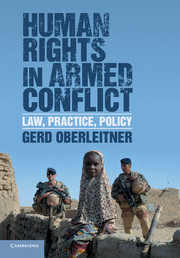Book contents
- Frontmatter
- Contents
- Acknowledgments
- Table of cases
- Table of Legal Instruments
- List of Abbreviations
- Introduction
- Part I Human rights in armed conflict: history of an idea
- Part II Human rights and humanitarian law: theory
- Part III Human rights and humanitarian law: challenges and commonalities
- Part IV The dynamics of war and law
- 13 The changing character of war
- 14 Governing internal armed violence
- 15 Human rights in situations of occupation
- 16 Context: the humanization of international law
- Part V Enforcement: practice and potential
- Conclusion
- Bibliography
- Index
- References
14 - Governing internal armed violence
Published online by Cambridge University Press: 05 March 2015
- Frontmatter
- Contents
- Acknowledgments
- Table of cases
- Table of Legal Instruments
- List of Abbreviations
- Introduction
- Part I Human rights in armed conflict: history of an idea
- Part II Human rights and humanitarian law: theory
- Part III Human rights and humanitarian law: challenges and commonalities
- Part IV The dynamics of war and law
- 13 The changing character of war
- 14 Governing internal armed violence
- 15 Human rights in situations of occupation
- 16 Context: the humanization of international law
- Part V Enforcement: practice and potential
- Conclusion
- Bibliography
- Index
- References
Summary
Towards a human rights law of internal armed conflicts?
As discussed earlier, the law of non-international armed conflicts, as laid down in Common Article 3 of the Geneva Conventions and later in Additional Protocol II of 1977, and as still largely expressed in customary law, is strongly influenced by human rights law and borrows from its language. This seems comprehensible, because such conflicts usually occur on the territory of a state and involve questions of how a government relates to those under its jurisdiction, albeit in hostilities. Given that an internal armed conflict is (at least mostly) confined to the territory of a given state, the extra-territorial application of human rights is also less of a problem (“internationalized” conflicts which spill across borders or involve non-state actors on various territories notwithstanding).
And because the law of non-international armed conflict provides only for minimum guarantees, the argument that it is lex specialis is also less tenable than in international armed conflicts. At the same time, it has repeatedly been highlighted that the lower level of protection under humanitarian law is legally illogical as well as morally reprehensible: “[w]hat is inhumane, and consequently proscribed, in international wars, cannot but be inhumane and inadmissible in civil strife.” This leaves potentially more space for human rights to fill gaps.
- Type
- Chapter
- Information
- Human Rights in Armed ConflictLaw, Practice, Policy, pp. 206 - 219Publisher: Cambridge University PressPrint publication year: 2015



